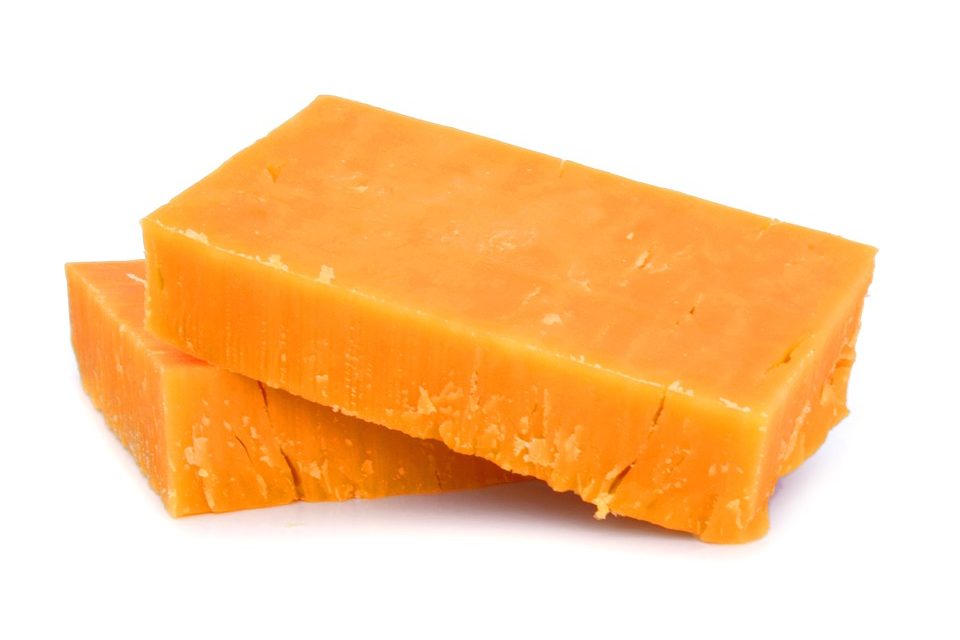Cheddar is a basic hard cheese. It is flavorful, creamy and firm. It is a cheese you can use in a variety of ways. You can cheddar slices in sandwiches, use it to top a casserole, or put it in soups and salads.
Preparation Time
30 minutes
Cook Time
1 hour and 30 minutes
Yield
1.1 to 1.3 kg cheese
Aging
3 to 6 months
Ingredients
Whole Milk (3 gallons)
Bioprox M265 Mesophilic Starter Culture
½ tsp liquid animal rennet
½ tsp Calcium Chloride
2 1/2 tbsp non-iodized salt
Equipment
large pot
thermometer
curd knife
ladle or spoon for stirring
colander
butter muslin/ cheese cloth
cheese hoop
cheese press
cheese cloth/ cheese wax for aging
brush for waxing
Instructions:
1. Slowly heat the milk to 320C in a large pot, stirring frequently. Make sure the temperature does not exceed 320 C. One way to make sure you don’t heat the milk too much is by doing a water bath. You can do this by putting the pot inside a bigger pot with the burner under that to control the temperature.
2. As the milk is heating, add the calcium chloride.
3. When the temperature reaches 300 C, add the culture. Sprinkle the powder over the surface of the milk. Give the powder 2 minutes to rehydrate and stir in an up and down motion.
4. Cover the milk and let it ferment for 1 hour while maintaining the target temperature.
5. Once the milk and culture have ripened, add the rennet. Stir in an up and down motion to make sure that the rennet works its way throughout the milk.
6. Remove from the heat and let the milk sit for 45 minutes or until the whey separates from the curd.
7. When you see a layer of mostly clear whey floating on top, cut the curds in ½ to ¾ inch cubes. You can use a curd knife or a curd cutter to do this.
8. Let the curds set for 5 minutes. Do not stir.
9. Slowly stir the curd while bringing it back to heat at 320 C. Do this for 30 minutes.
10. Slowly bring the heat up to 380 C. Maintain the heat and continue to stir for another 30 minutes or until the curd is firm. Make sure your curd is well cooked. It should be firm. When you press it between your fingers, it should have a moderate resistance. Make sure that enough moisture is removed during the cooking process. Moisture contains lactose. If carried into the pressing and aging stages, the cheddar will become chalky, acid tasting and leaky.
11. Remove the pot from the heat and let it sit for 20 minutes. This will allow the curds to settle at the bottom of the pot.
12. Put the colander in another large pot. Pour the curds into a colander. Set aside some whey. You’ll need it in a moment. Allow the curds to drain for 15 to 20 minutes. Make sure all the whey is removed during this phase.
13. Remove the colander from the pot and transfer the semisolid mass of curd on a cutting board.
14. Cut the slab into five slices and put it back in the colander.
15. Heat the whey that you have to 430 C. Turn off the stove. Let the colander sit on top of the pot with the whey. Make sure that the colander is on top of the pot and not sitting in the whey. The slices should not be submerged in whey. Cover the cheese slab with a towel.
16. Now we begin the cheddaring process. Flip the curd slabs every 15 minutes for the next 2 hours (This is 8 flips during the entire process). This process gives your cheese its unique flavor. Make sure to keep the whey at 430 C. On the 8th flip, the slab should be shiny and slightly firm (like a chicken breast).
17. After 2 hours, cut the curd slab into half-inch cubes.
18. Put the curds in another pot. Take the salt and sprinkle it over the cheese curds. Mix the salt in the curd by using a wooden spoon or your hands.
19. Line the cheese mold with the muslin or cheesecloth. Take the curds and put them in the mold. Take the edges of the cheesecloth and wrap it on top of the cheese curds. Make sure everything is covered.
20. Press the cheese at 25 pounds of pressure for 60 minutes.
21. Carefully remove the cheese from the press and the mold. Unwrap it and flip. Get a fresh cheese cloth and re-wrap the cheese. Place it back in the mold and press at a 40 pound pressure for the next 12 hours.
22. Remove the cheesecloth. Flip the cheese and put it back in the mold. Press it at 50 pounds for another 12 hours.
23. Remove the cheese from the mold and air dry it for 2 to 3 days, flipping it every 12 hours until it is smooth and dry to the touch.
24. Wax or vacuum seal the cheese. Age at a temperature of 120 to 150 C for 3 to 6 months. Turn the cheese over weekly to keep the moisture even.
5 Health Benefits of Cheddar
1. Cheddar is an excellent source of protein. It gives 25g of protein for every 100g.
2. Cheddar is very high in calcium. 100g of cheddar provides 72% of the RDA of calcium.
3. Cheddar is rich in micronutrients. It is an excellent source of vitamin A, B2, B12, Phosphorus, Selenium and Zinc.
4. As a fermented dairy, cheddar appears to be neutral or protective against stroke. It reduces the inflammatory markers for most people.
5. Fermented dairy products like cheddar may contain probiotics, which have positive health benefits in the gut.








